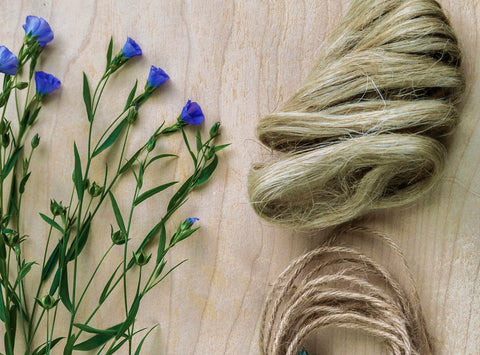We're passionate about fabric at Sew Me Sunshine. Here's our guide to everything linen and ramie, and tips on how to sew with these linen dressmaking fabrics.
WHAT IS LINEN FLAX FABRIC?

WHAT CAN LINEN BE BLENDED WITH?
- Linen Viscose - due to the viscose content the fabric has a fluid drape and it is less prone to wrinkling. It is ideal for sewing dresses that require a drapey fabric
- Linen TENCEL™ - like viscose linen blends, the TENCEL™ blend results in a fabric that has more drape
- Linen Cotton - cotton softens the linen fabric and it wrinkles less. It is commonly used for sewing trousers, structured dresses & tops and summer weight jackets
- Linen Polyester - polyester softens the linen and it has a less wrinkled appearance
- Linen Silk - silk fibres softens the linen fabric
- Linen Spandex - elastane can be blended into woven linen fabrics which gives the fabric a slight stretch. This blend is perfect for sewing fitted trousers
BENEFITS OF LINEN FABRIC?
- It does not have any insulative properties allowing the wearer to feel cool, making it perfect for warmer climates
- Withstands high temperatures
- Durable - 8 times stronger than cotton
- Easy to sew with as it is not stretchy or slippery
- UV resistant
- Mildrew + insect resistant
- Versatile
- Machine washable
- Biodegradable
DISADVANTAGES OF LINEN FABRIC?
- Wrinkles easily
- Prone to shrinkage
- Low elasticity
- Harder to dye than ramie
- Prone to fraying so it is important that you finish your edges
IS LINEN FABRIC SUSTAINABLE?
WHAT IS RAMIE FABRIC?


BENEFITS OF RAMIE FABRIC?
- Takes dye well
- Blends well with other fibres
- Durable - it is stronger than linen and it's strength increases when wet
- Holds garment shapes well
- Absorbent - more so than cotton
- Antibacterial and mould resistant
- Withstands high temperatures
- Easy to sew with as it is not stretchy or slippery
- Versatile
- Machine washable
- Biodegradable
DISADVANTAGES OF RAMIE FABRIC?
- Prone to shrinking slightly
- Wrinkles easily
- Stiff - does soften with washing but tends to be rougher in feel than linen
- Raw edges are prone to fraying
- Low elasticity
IS RAMIE FABRIC SUSTAINABLE?
Like linen flax ramie is seen as a sustainable fibre because the nettle plant has a long fibre producing life span of up to 20 years and can be harvested up to 6 times a year. Ramie is known to resist bacteria, mould, UV rays, rot and insect attacks which means that chemicals are not required for it to grow. 100% ramie fabrics like 100% linen fabrics are biodegradable and recyclable.
LINEN VS RAMIE FABRIC?
Due to both fabrics having extremely similar properties and thus visually appearing the same it is very difficult to distinguish the two. Ramie can be woven finer than linen so you will not find 100% linen fabrics that are under 3oz in weight (i.e. linen voile). Ramie also tends to have less natural slubs than linen, and it often has a more definite surface sheen than linen. Ramie does tend to be rougher to touch than linen and doesn't soften as much as linen does with washing. Both fabrics are deemed sustainable as they are made from naturally growing plants that do not require chemicals to grow.
SEWING PROJECTS FOR LINEN + RAMIE FABRIC
Sewing projects for linen and ramie fabrics depend on the weight of the fabric, it is important to look at the fabric weight on each listing. For lighter weight linen or ramie fabrics they are perfect for sewing shirts and shirt dresses, whereas heavier weight linen or ramie fabrics they are ideal for sewing boiler suits, trousers, culottes, jumpsuits, blazers, overalls, skirts, shift tops / dresses and some structured dresses. When ramie or linen is blended with viscose then the fabric is less structured and has a more fluid drape making it perfect for floaty dresses, blouses and skirts. Whereas when ramie or linen is blended with cotton the fabric remains fairly structured.

L-R Top - Blanca Flight Suit by Closet Core Patterns, Zadie Jumpsuit by Paper Theory, Hughes Dress by Friday Pattern Company.
L-R Bottom - Colibri Overalls by I AM Patterns, Ellis + Hattie Dress by Merchant and Mills, Portobello Trousers by Nina Lee.
TIPS FOR SEWING WITH LINEN + RAMIE FABRIC
- Pre-wash your fabric due to possible shrinkage
- Consider the weight of the linen and ramie fabric you are purchasing
- Follow the weave and texture of the fabric when you are cutting out your project
- Make sure you finish your edges properly to avoid fraying - you could use a simple zig zag stitch to finish your edges, or if you have an overlocker then you can use that. Otherwise, you could consider using French Seams for light-medium weight linen or ramie fabrics, or Hong Kong Seams for heavier weight linen or ramie fabrics
- Make sure you press your fabric as it will make it easier to sew with. It is beneficial to press it whilst it is damp
- Use a universal sewing machine needle, the size of the needle will depend on the weight of the fabric
- Linen and ramie can be sewn using a standard straight stitch (stitch length 2.5mm)

---------------
